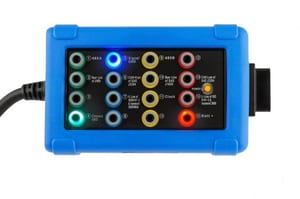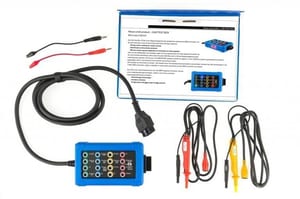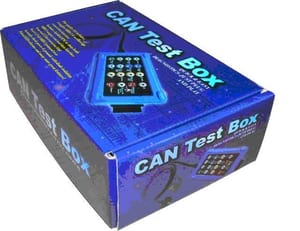CAN Test box CTB
With the Breakout CAN test box, you can easily check the communication connection of the OBD, ideal when an OBDII/EOBD system does not respond. This smart breakout box makes testing all connections of the J1962 OBDII connector safe and easy.
CAN Test Box uses the Pass-through technology.
Communication between diagnostic systems and vehicles takes place via different protocols. In systems like CAN-Bus and KWP2000, not all signals are sent to the OBDII without a connected scanner. Therefore, the Breakout CAN test box is equipped with a fixed contra OBDII connector for connecting a scanner. This ensures that you have access to all signals.
The Breakout CAN test box uses colored LEDs to make power and ground points visible at a glance. Flashing LEDs immediately indicate the different communication systems.
Read more
CAN TEST BOX
Discover the revolutionary CAN TEST BOX
What is a CAN TEST Box (CTB) Kit?
The CAN Test Box (CTB) is an innovative diagnostic tool that you easily connect to your car's OBDII connector, allowing you to quickly and effectively detect electrical faults.
- Quick check of power and ground circuits
- Identification of the communication protocol
- Recording and receiving data signals with a scope
Modern workshops need equipment that helps diagnose through the communication port, especially with the latest CAN-Bus vehicles. If the diagnostic tool cannot connect to the car, the OBDII/EOBD system does not respond, or a CAN-Bus related fault code is stored, you should first test the communication port.
The operation is simple: the breakout box with standard banana plug connections provides access to all connections in the J1962 OBDII connector. This allows you to quickly and safely test each connection of the OBDII connector. The CTB is a 16-pin breakout box for the OBDII diagnostic connector, with the following additional features that create a new universal diagnostic tool:
- Pass-through technology
- Intuitive interface
- Compatible with any scope and scanner
Details
Pass-through technology
1. CAN-Bus system
The CTB has a fixed OBDII connector to which you connect a scanner to set up CAN-Bus communication with the car. This is important because not all CAN-Bus signals reach the OBDII connector when the ignition is on. Depending on the type of network, a scanner must log in as one of the communication nodes of the CAN-Bus system to receive the bus signal. Without a recognized scanner, the system will not send a signal to the unoccupied node. Some networks require more than this; a scanner must get permission from the Gateway Control Module to receive the signal on the OBDII connector (e.g., with Mercedes-Benz or Volvo).
A standard breakout box does not give you access to the bus signals if the system requires a connected scanner or gateway permission. However, with the CTB, you can communicate via a scanner (universal or original) and thus gain access to the bus signals, regardless of the network structure. This is crucial in the digital world, where "no access" means no signals are received.
2. Other OBDII / EOBD standard communication
There are various communication protocols between a scanner and the OBD system, established as OBDII/EOBD standards by SAE and ISO. All OBD vehicles must comply with these standards.
- SAE document J1850 describes the VPW and PWM protocols, mainly used in American cars before the introduction of CAN-Bus.
- ISO 9141-2 document describes the standard protocol used in most Asian and European cars, later modified and published as ISO 14230, known as KWP2000.
Each of these pre-CAN-Bus OBD standards uses different connections of the OBDII connector for communication, as shown below:
| Type of protocol | Signal connection 1 | Signal connection 2 |
|---|---|---|
| SAE J1850 VPW and PWM | Bus (+) on 2 | Bus (-) on 10 |
| ISO 9141-2 & KWP2000 | K-Line on 7 | L-Line on 15 |
The bus signals of the SAE J1850 protocols are always present on the OBD connector. However, the signals of the ISO 9141-2 and KWP2000 protocols (most European and Asian cars before the CAN-Bus generation) are only received on the OBD connector if a scanner communicates with an ECU, making the Pass-through technology necessary.
Intuitive interface
Colored LEDs
When the OBDII connector is connected to the car's diagnostic port, the LEDs of pins 4, 5, and 16 light up, indicating both ground points and power supply.
The LEDs will start flashing at the pins where bus signals are detected.
The colored LEDs are so intuitive that you can check the power and ground points at a glance and recognize the car's communication system. This allows you to measure the bus signals with your scope by simply plugging the banana plugs into the flashing LEDs.
Usage
The CTB pin connections are made with standard 4 mm banana plugs. The CTB kit includes a pair of silicone test cables with a standard 8 mm BNC connector on the other side, so almost all scopes can be connected. The CTB is an ideal accessory for virtually any scope equipped with standard 8 mm BNC connectors, including the Hanatech Ultrascan scanner and Hanatech Ultrascope. Each test cable is equipped with a banana plug for the ground connection. You can choose between "Chassis ground" on pin 4 or "Signal ground" on pin 5, depending on where the best scope signal is presented.
Quality product
The high-quality components used in the manufacturing of the CTB have proven their reliability over many years. The CTB is equipped with various protections, including multiple circuits on pin 16 to prevent short circuits, and independent protection of ground pins 4 and 5 with a diode for independent ground measurement.
Advantages & drawbacks
- OBD2 connection for connecting a scanner
- Intuitive interface: with colored LEDs that immediately display the status of power supply, ground points and communication systems
Specs summary
- Suitable for car brand Abarth, Alfa Romeo, Aston Martin, Audi, BMW, Bentley, Chevrolet, Chrysler, Citroën, Dacia, Daihatsu, Dodge, Ferrari, Fiat, Ford EU, Ford USA, General Motors, Honda, Hyundai, Infiniti, Jaguar, Jeep, Kia, Lamborghini, Lancia, Land Rover, Lexus, Maserati, Mazda, Mercedes, Mini, Mitsubishi, Nissan, Opel, Peugeot, Porsche, Renault, Rolls-Royce, Saab, Seat, Skoda, Smart, Subaru, Suzuki, Tesla, Iveco, Toyota, Universal, Volkswagen, Volvo
- Features Component testing
- Protocol CAN, EOBD, ISO 9141, J1850 PWM, J1850 VPW, K-Line, KWP-2000, OBD2








